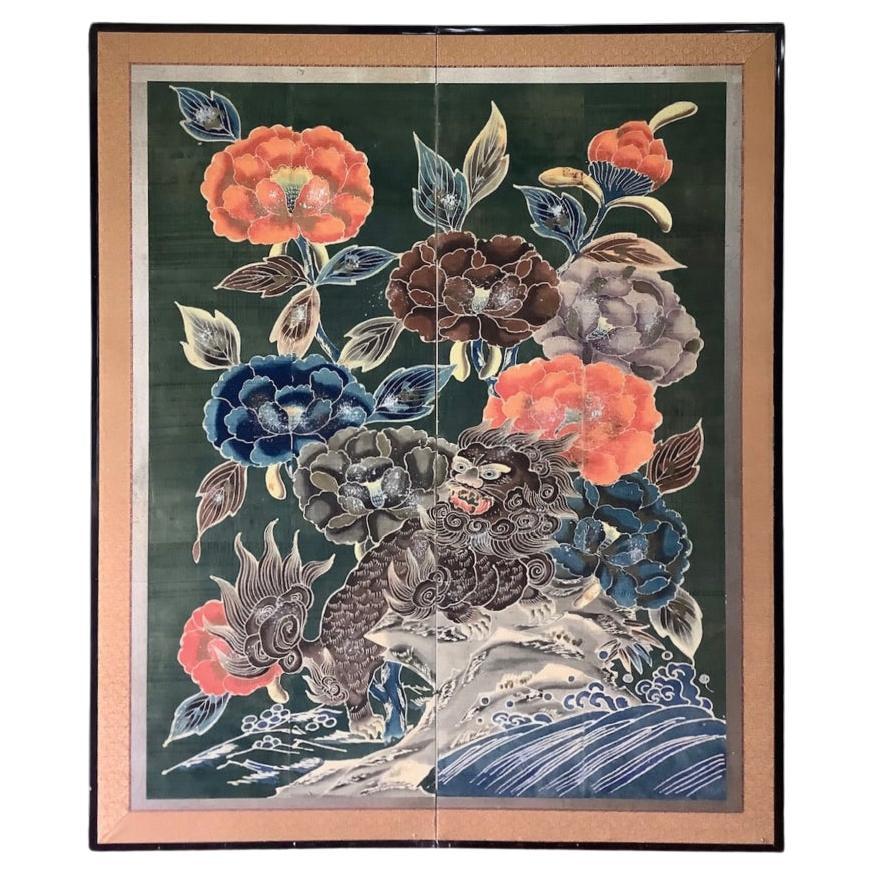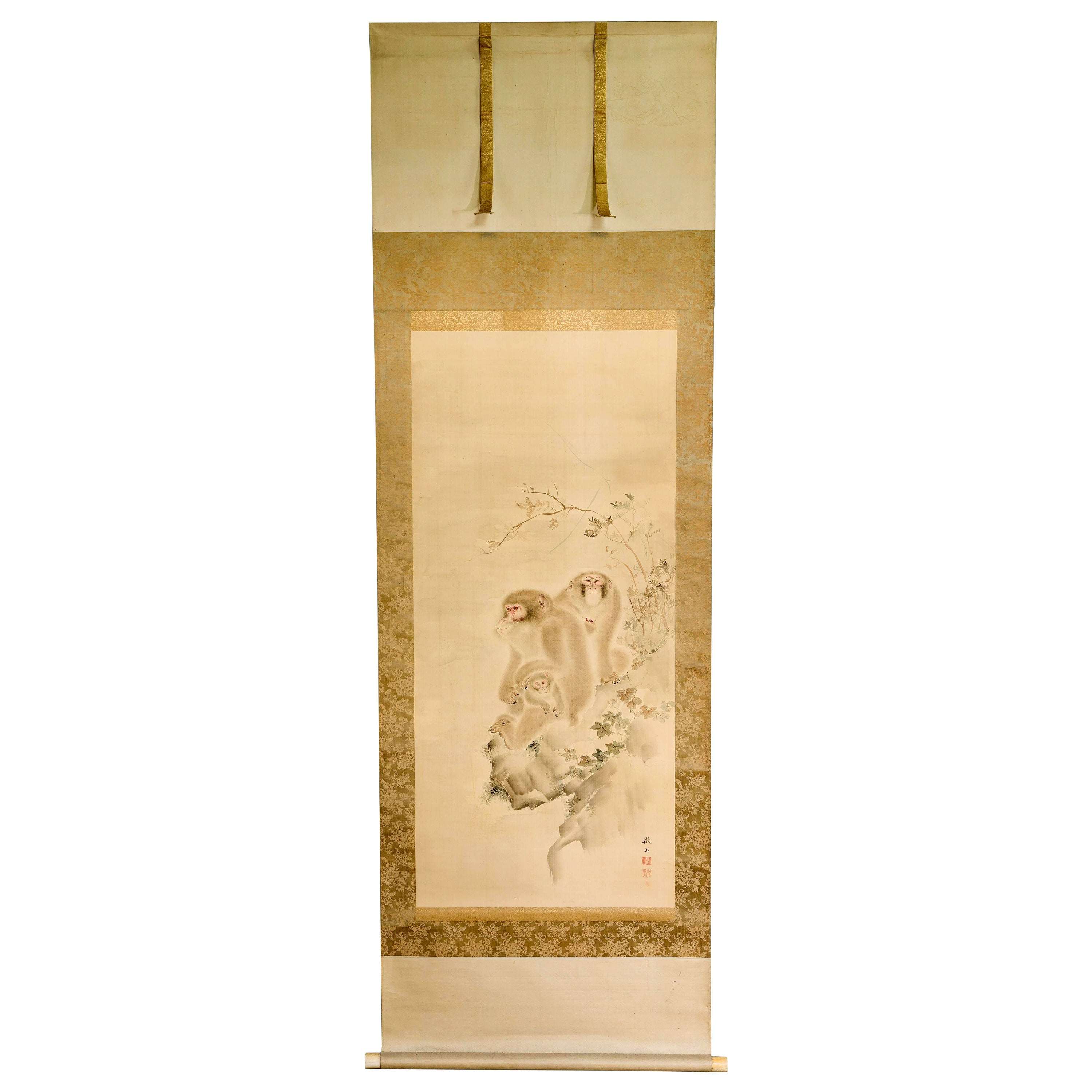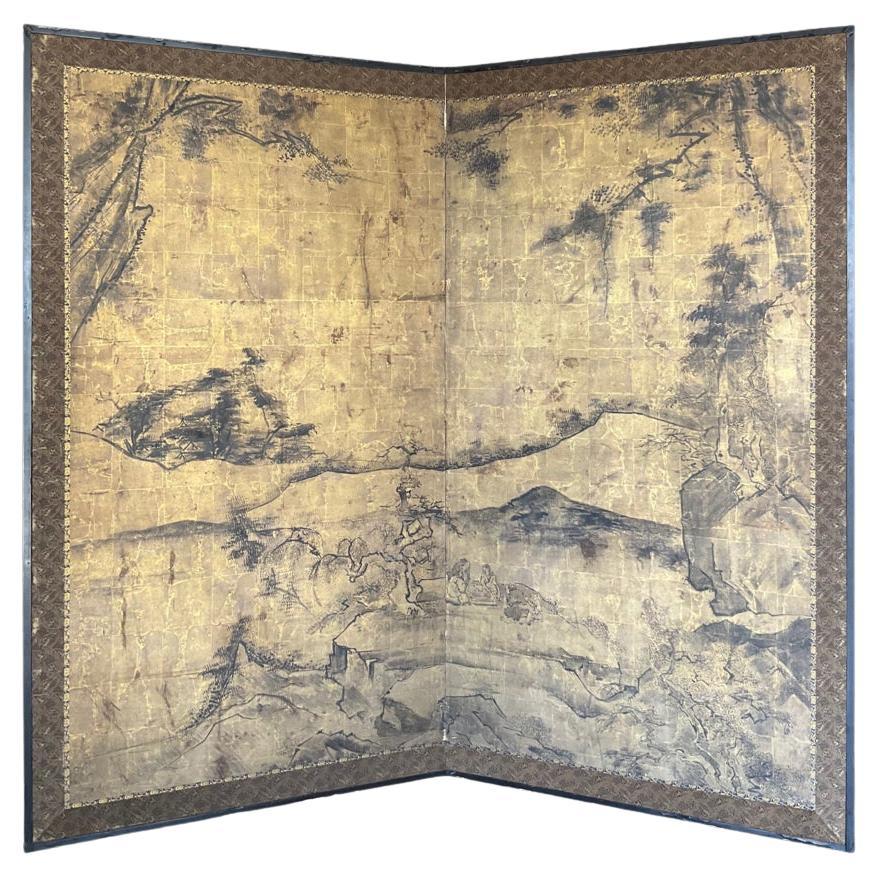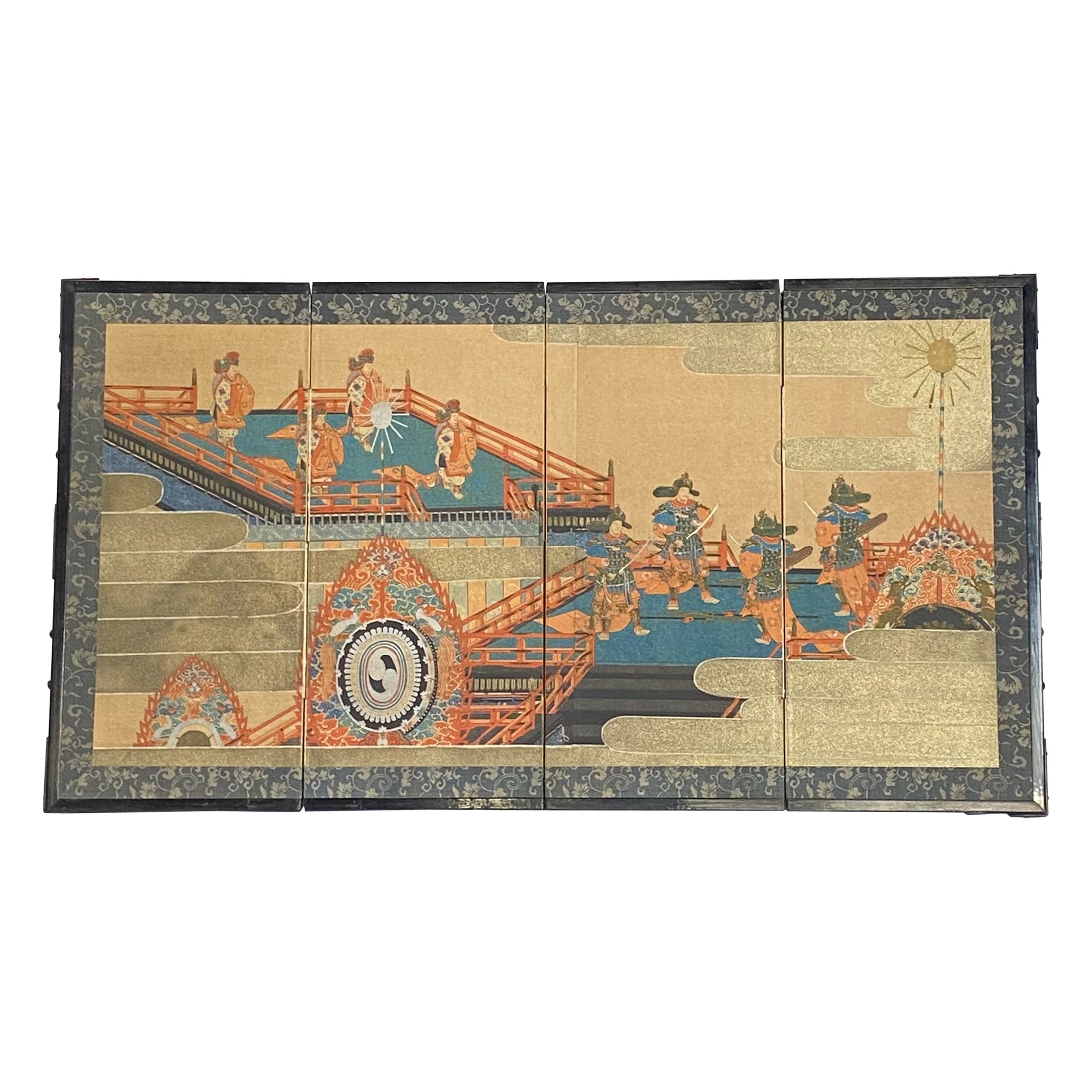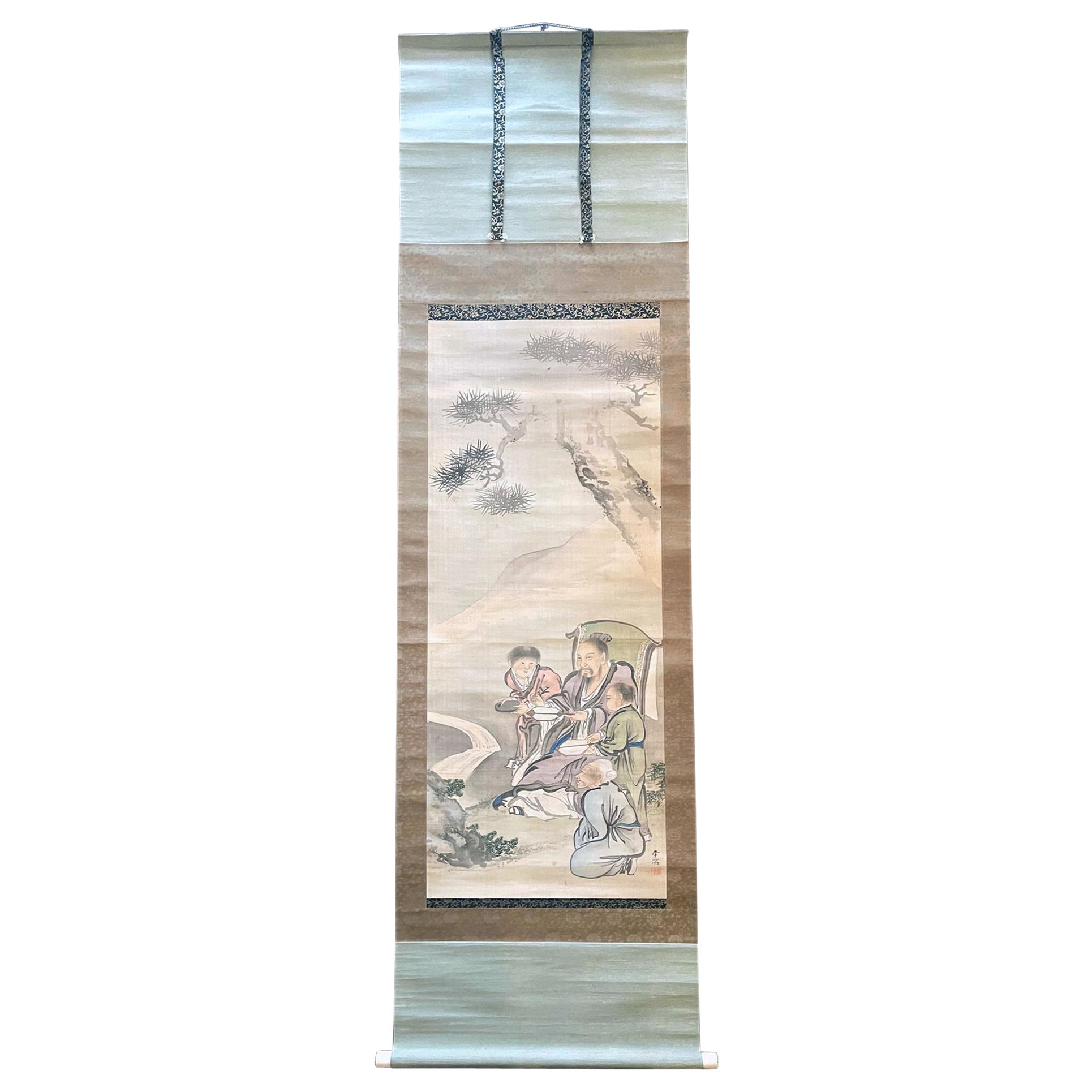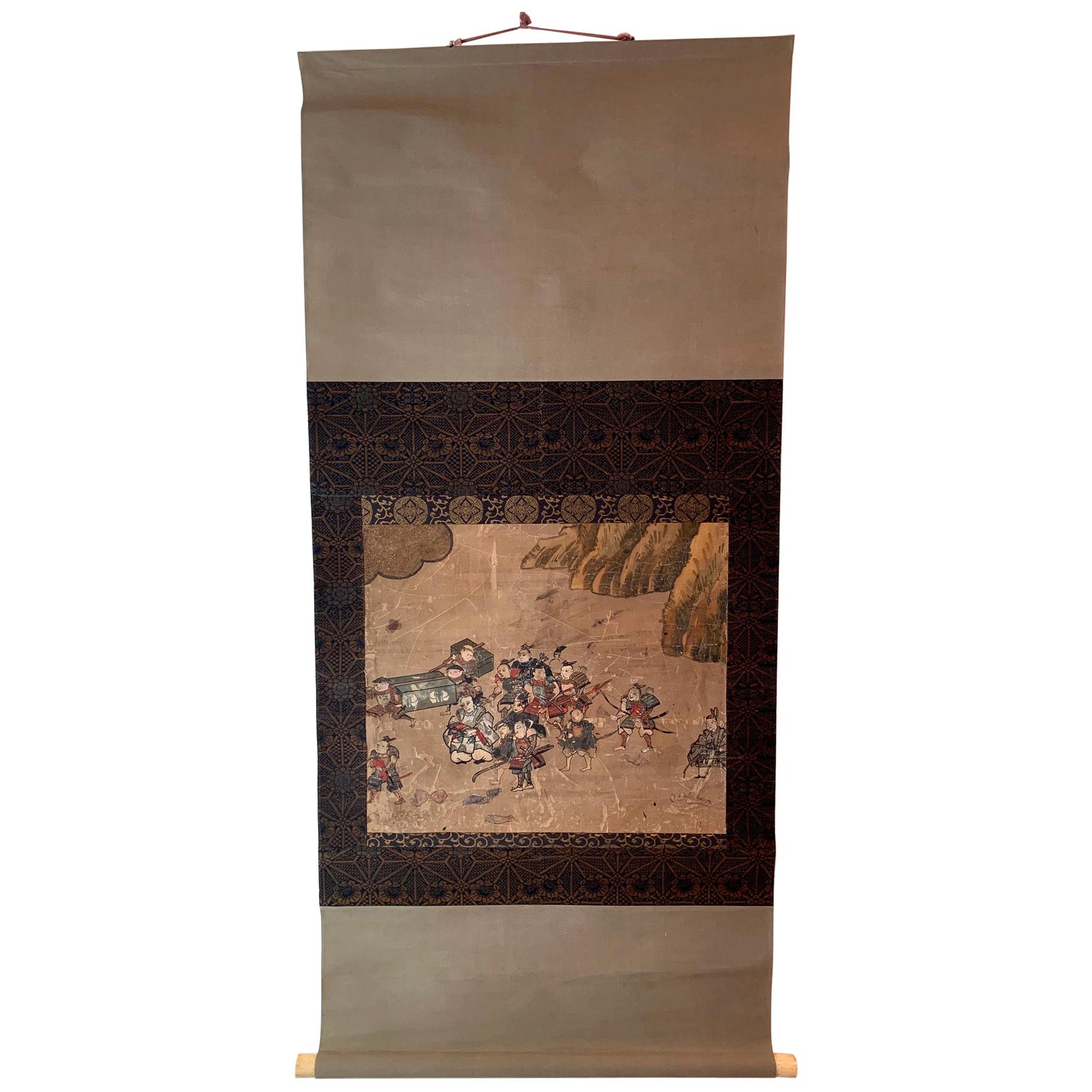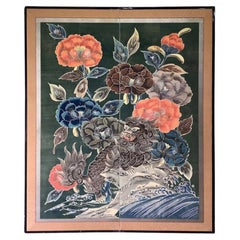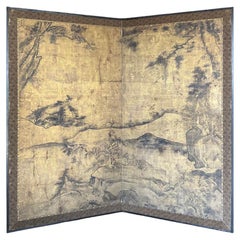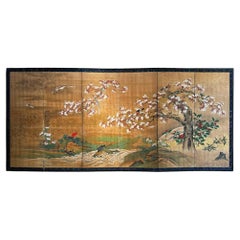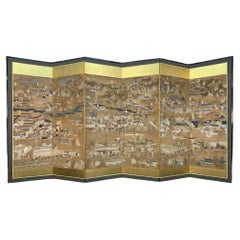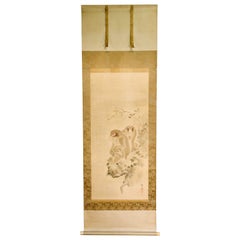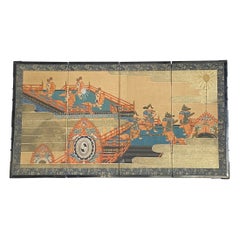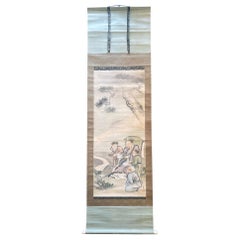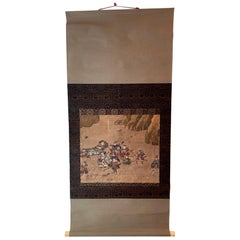Items Similar to Late Edo period Tsutsugaki 筒描 Auspicious Shishi Batik Screen
Want more images or videos?
Request additional images or videos from the seller
1 of 7
Late Edo period Tsutsugaki 筒描 Auspicious Shishi Batik Screen
$5,430
£4,151.52
€4,781.72
CA$7,609.09
A$8,494.84
CHF 4,451.17
MX$103,985.17
NOK 56,529.88
SEK 53,300.50
DKK 35,686.45
About the Item
Auspicious Shishi Batik Screen
Period: Late Edo
Size: 145x173 cm (57x68 inches)
SKU: PTA62
Step into the mythical world of late Edo Japan with our radiant batik screen depicting the Shishi, or Japanese mythical lion. This extraordinary piece features a dynamic scene of Shishi leaping amidst waves, surrounded by bold white, dark, and red peonies against a dark green backdrop.
This extraordinary screen is steeped in symbolism. Shishi, revered as the king of beasts, symbolizes strength, courage, and protection, warding off evil spirits. The peony, or Botan, known as the king of flowers, represents prosperity, honor, and nobility. Together, they create an auspicious environment, inviting positivity and blessings into your space.
About the technique:
Tsutsugaki (筒描) is a Japanese technique of resist dyeing that involves drawing rice-paste designs on cloth, dyeing the cloth, and then washing off the paste.[1]
The rice paste is typically made from sweet rice, which has a high starch content and is therefore rather sticky. The paste is applied through a tube (tsutsu) similar to a piping bag. A related process is to apply the paste through a stencil, a technique known as katazome.
The cloth dyed is typically cotton, and the dye is typically indigo, so the design is usually white on blue. Banners for shops or other purposes are sometimes made in this manner.
The designs are often creatures from Japanese mythology such as the crane or the tortoise, or a family crest, or a name (written in kanji). Flowers and trees are common motifs as well.
- Dimensions:Height: 56.3 in (143 cm)Width: 68.9 in (175 cm)Depth: 0.79 in (2 cm)
- Style:Edo (Of the Period)
- Materials and Techniques:
- Place of Origin:
- Period:
- Date of Manufacture:Unknown
- Condition:Condition report upon request.
- Seller Location:Fukuoka, JP
- Reference Number:1stDibs: LU8121239720652
About the Seller
5.0
Vetted Professional Seller
Every seller passes strict standards for authenticity and reliability
Established in 1998
1stDibs seller since 2023
57 sales on 1stDibs
Typical response time: <1 hour
- ShippingRetrieving quote...Shipping from: Tambon Hang Dong, Thailand
- Return Policy
Authenticity Guarantee
In the unlikely event there’s an issue with an item’s authenticity, contact us within 1 year for a full refund. DetailsMoney-Back Guarantee
If your item is not as described, is damaged in transit, or does not arrive, contact us within 7 days for a full refund. Details24-Hour Cancellation
You have a 24-hour grace period in which to reconsider your purchase, with no questions asked.Vetted Professional Sellers
Our world-class sellers must adhere to strict standards for service and quality, maintaining the integrity of our listings.Price-Match Guarantee
If you find that a seller listed the same item for a lower price elsewhere, we’ll match it.Trusted Global Delivery
Our best-in-class carrier network provides specialized shipping options worldwide, including custom delivery.More From This Seller
View AllLate Edo period Tsutsugaki 筒描 Auspicious Shishi Batik Screen
Located in Fukuoka, JP
Auspicious Shishi Batik Screen
Period: Late Edo
Size: 145x173 cm (57x68 inches)
SKU: PTA62
Step into the mythical world of late Edo Japan with our radiant batik screen depicting the...
Category
Antique 19th Century Japanese Edo Paintings and Screens
Materials
Cotton, Wood
Early Edo Period Chinese-Inspired Screen
Located in Fukuoka, JP
This remarkable screen from the early Edo period, circa the 17th century, showcases the influence of early Chinese art forms with its intricate ink work on a gold leafed surface. The...
Category
Antique 17th Century Japanese Edo Paintings and Screens
Materials
Gold Leaf
Enchanting 'Seasons' Edo Screen
Located in Fukuoka, JP
Enchanting 'Seasons' Edo Screen
Period: Edo
Size: 378x175 cm
SKU: PTA120
Transport yourself to the enchanting beauty of Japanese nature with our exquisite...
Category
Antique 18th Century Japanese Edo Paintings and Screens
Materials
Wood, Lacquer, Paper
Edo Period Kyoto Screen (2/2)
Located in Fukuoka, JP
Edo Period Kyoto Screen
Period: Edo period
Size: 343 x 176 cm (134.6 x 69 inches)
SKU: RJ69/2
This stunning Edo period screen depicts typical scenes of...
Category
Antique 18th Century Japanese Edo Paintings and Screens
Materials
Silk, Wood, Paper
Edo Period Seasonal Transition Screen
Located in Fukuoka, JP
Edo Period Seasonal Transition Screen
Period: Edo
Size: 368 x 153 cm
SKU: PTA148
This exquisite six-panel screen, adorned with golden flakes, beautifully portrays the seamles...
Category
Antique 19th Century Japanese Edo Paintings and Screens
Materials
Gold Leaf
Edo Period Kyoto Screen
Located in Fukuoka, JP
Edo Period Kyoto Screen
Period: Edo period
Size: 343 x 176 cm (134.6 x 69 inches)
SKU: RJ69
This stunning Edo period screen depicts typical scenes of d...
Category
Antique 18th Century Japanese Edo Paintings and Screens
Materials
Silk, Wood, Paper
You May Also Like
Japanese Silk Scroll Painting of Moneys Edo Period Mori Tetsuzan
Located in Atlanta, GA
A Japanese mounted vertical hanging scroll painting by Mori Tetsuzan (Japanese, 1775-1841) circa 19th century Edo period. The watercolor and ink on silk ...
Category
Antique 19th Century Japanese Japonisme Paintings and Screens
Materials
Silk, Paper
Antique Japanese Wood Block Printed Table Top Folding Screen
Located in San Francisco, CA
Antique Japanese small table top four panel folding screen.
Wood block print on paper.
First quarter 20th century.
Perfect to use as wall art.
Category
Early 20th Century Japanese Meiji Paintings and Screens
Materials
Paper
Japanese Silk Scroll by Haruki Nanmei Edo Period
Located in Atlanta, GA
A Japanese hanging silk scroll by late Edo period painter Haruki Nanmei (1795-1878). The gouache painting was in the tradition of Kano school and depicts an old scholar dressed in lo...
Category
Antique 19th Century Japanese Edo Paintings and Screens
Materials
Silk, Paper
Antique Japanese Hanging Scroll Attributed to Iwasa Matabei
Located in Atlanta, GA
An antique ink and color on paper hanging scroll (kakejiku) with brocade border. It appears to be a fragment of a larger hand scroll depicting a procession of a lord with his entoura...
Category
Antique Early 17th Century Japanese Japonisme Paintings and Screens
Materials
Silk, Paper
Japanese Silk Embroidery Tapestry Meiji Period
Located in Atlanta, GA
A spectacular Japanese embroidered silk panel beautifully presented in a gilt frame suspended in a lucite shadow box with gilt wood border. The silk picture is dated to 1890-1910s toward the end of Meiji Period, when Japanese started to participate international expose by presenting its best art and craft. Elaborate embroidered silk tapestry like this was very popular among westerners due to its superb craftmanship and also exotic subject matter that was often derived from classic Japanese folklore, mythology and various motifs. The tapestry on offer is such an example. It depicts an old couple...
Category
Antique 1890s Japanese Japonisme Textiles
Materials
Fabric, Silk, Lucite
Framed Japanese Antique Embroidery Sennin Tapestry Meiji Period
Located in Atlanta, GA
A stunning Japanese embroidery tapestry circa 1880s-1900s from late Meiji period, presented with an original wood frame with inner gold trim. The tour-de-force embroidered tapestry s...
Category
Antique 1890s Japanese Meiji Textiles
Materials
Silk, Giltwood
More Ways To Browse
Edo Wood
Japanese Edo Period Screens
Painted And Stenciled Furniture
Hand Painted Banner
Asian Screens Green
Japanese Screen Tree
Green Japanese Screen
Green Tortoise
Family Crest Wood
White Tortoise
Dark Green Bag
Crane Screen
Antique Japanese Indigo
Japanese Crane Screen
Japanese Shishi
Shishi Lion
Japanese Screens With Cranes
Japanese Screen Waves
